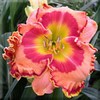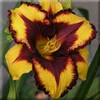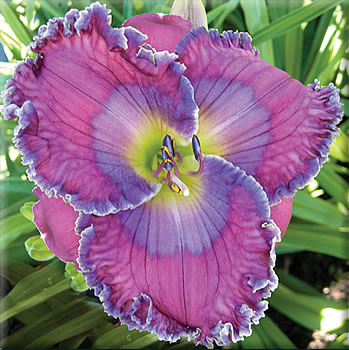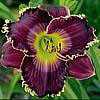Decorative elements of the perianth
Eye
The term eye defines the ring that surrounds the flower’s throat, which has a different color than the inner area (petals).
The eye wasn’t a connate feature and it does not appear in the botanical flower form of the specie, and its widespread presence in modern variations is a result of breeding works.
In the older variations, mainly unicolored, the eye was a rare feature and its presence was not very diverse and morphologically inconspicuous.
In the valued modern variations, the presence of an eye is not mandatory. There are many variations, in which the colors, shape of the flower, throat or frill seem to be sufficient artistic accents to make the variation fulfilled in the terms of attractiveness and beauty of its flowers (fig. 46).
Fig. 46 Modern daylily variations without an eye

Spectral Elegance
|

Jasmine Rossi
|

Tropical Breeze
|

Our Friend Jim Saddler
|
Nevertheless, the presence of an eye in the daylily flowers cannot be overestimated. Its simple definition conceals unlimited possibilities in terms of size, form, color, and multiplied number of various solutions regarding their mutual relations with other decorative elements of the daylily flower.
The ring that surrounds the flower throat in the simplest forms is compact, round, and adjoins with its inner edge to the throat’s outline (fig. 47). The term “eye” derives from these forms, and it kind of stopped matching to the “evolutionary” modifications of its appearance, introduced by the modern breeding.
Fig.47 Variations with classic form of the eye

Spacecoast Eye for Passion
|

My Sunny Valentine
|

Sp. Technical Knock Out
|

Blackberries&Cream
|
In some variations the eye is located centrally, almost entirely excluding the throat out of colorful elements that comprise the decoration of the flower (fig. 48).
Fig.48 Variations with the “eye” covering the throat

Halloween Kisses
|

Andy Candy
|

Special Graces
|

Panther Eyes
|
In other flowers the ring that surrounds the throat recedes from it towards perimeter, and then in the form of a looser circle of different width, more clearly separates the throat from the color of petals, thereby exposing its size, depth and colour (fig. 49).
Fig. 49 Variant of wide eye in daylily variations

Rock Solid
|

Parrot Jungle
|

Ebony Pools
|

Anita's Gift
|
The widest eyes often spread to the entire width of inner petals, over 2/3 of their length and sometimes spread even to the outer petals. This way they create original two-color daylily flowers with various combinations of colors, shades and contrast (fig.50)
Fig. 50 Two-color variations of daylily flowers

Mysterious Eyes
|

Black Eyed Bully
|

Cajun Christmas
|

Calling All Angels
|
Invaluable contribution to the creation of such variations was made by one of the greatest modern breeders of daylilies - P.Stamile http://floydcove.com who, while expanding the breeding of tetraploid variation with tetraploid form of Peppermint Delight variation obtained from the di form, achieved numerous, multi-colored array of daylilies with extension of the eye’s color to large area of inner space, and dislocation of the petal’s pattern to outer areas (fig.51).
Fig. 51 Two-color variations of daylily flowers from the breeding of P.Stamile

Pepermint Delight
|

Giant Panda
|

Bart Roberts
|

Christopher Mody Fall
|

Ruby Storm
|

Sir Francis Drake
|

Walter Kennedy
|

Firecracker Parade
|
While referring the definition of an eye to the element surrounding flower’s throat also forms other than circle, or forms close to a circle, which can comprise a border of daylily throat, should be considered under this definition. Nature has created diverse forms, which sometimes surprise with their originality. Usually they include shape of a triangle or three semicircular outlines that encircle basal part of the inner areas (fig. 52).
Fig. 52 The most common patterns of the eye in daylily variations

Extravagant
|

Cave Creek Canyon
|

Sp. Ojo Rojo
|

Sulphurite Prism
|

Spanish Fiesta
|

Autumn Tempest
|

Concert Music
|

Rock Candy
|
In some variations, there can be noticed an eye in the form of dark smudge surrounding the throat, along with radiating arrows spreading toward outer borders of petals
(fig. 53).
Fig.53 Unconventional patterns of the eye in daylily variations

Stellar Masquerade
|

Extravagant
|

Goldenzella
|

Caesar Augustus
|
Eye of the daylily flower besides the size, extend and variety of shapes, in many variation also differs in a way of accenting its presence in the central part of the flower. Shape of the eye is not always outlined by a uniform, homogeneous color change in comparison to the color of inner areas. Sometimes it’s very subtle, delicate and even barely visible (fig. 54).
Fig. 54 Variants of subtle eye patterns in daylily variations

Caesar's Head
|

Here and Now
|

Smoochie Mama
|

Pearl Necessity
|
In some variations the eye creates colorfully complex structure – two or even multicolor (fig. 55)
Fig.55 Colorfully complex colors of daylily eye

Wheel of Time
|

Throught the Looking Glass
|

Diane Marie Kraml
|

Blue Sky Baby
|
In other variations, it adopts forms of finesse engraved patterns, which in regard to the general reception of flower’s attractiveness have sometimes clearly dominant role (fig. 56)
Fig.56 Engraved eye patterns in the daylily variations

The Butler Did It
|

Ledg. Winter Memories
|

Ledg. Cajun Carnaval
|

Get Jiggy
|
The discussion regarding relations between the eye and the outline of inner areas is justified by the observation of coloristic concurrence between these elements, which is probably genetically defined. Similarly to the coloristic relation of throat and outline of inner areas, there are cases of many variations, in which color of the eye is color combined with colorful ending of petals’ border (fig. 57).
Fig.57 Daylily variations with coloristic concurrence of eye color and petals’ border

Special Candy
|

Hemingway
|

Franks Catnappin
|

Time Moves On
|

Barbies Favorite
|

Seminole Princess
|

Sunshine All Day
|

Sp. Sweet Eye
|
The breeding often uses this fact to expand the colors of outline of inner areas in comparison to the solutions of the first generation. Thereby, in many modern variations, the significant width of the colored border of frill decorated petals that is integrated in terms of color and size with the eye surrounding the flower’s throat, creates forms of the most perfect artistic and aesthetic solutions (fig.58).
Fig.58 Daylily variations with relation: colorful eye/wide frill

Sens of Wonder
|

Parrots of the Caribbean
|

Happy Happy
|

Doug Warner
|

Tom Adams
|

Mulberry Lane
|

Aleksander Hay
|

Lies and Lipstick
|
Decorative element of the central part of the perianth, so called “watermark” that can be spotted in some modern daylily variations, can be regarded as special form of an eye (fig.59).
It is a sharply outlined zone of discolored petals that surrounds the throat and makes a shape of ring (a,c) or comes out of the bottom of calyx (b,d). The discolored surface is covered by subtle rays radiating toward the perimeter that are whitened in comparison to the color of the petals. Hence the name of this item: “watermark”.
Fig.59 Daylily variations with “watermark”

All of My Love to You (a)
|

Fame (б)
|

Danny Steve Mitchell (в)
|

Enticing Elegance (г)
|
It’s hard to say to what extent the origin of this new, for daylily flowers, decorative accent is related to the throat or to the eye, or in what degree those both structures involved in the breeding treatments, are responsible for its presence.
Regardless of the above, the watermark is an important element of progress in the daylily breeding, and the variations in which it appears are sought after and widely recognized as particularly valuable.
The spreading of the eye pattern from the inner areas to the outer areas is the next important element that affects the decorative value of the daylily flowers.
The merit of obtaining such solution, as it was mentioned above, combines with the introduction of tetraploids to the breeding - diploid forms genetically processed into tetraploid.
The other instance, besides the above-mentioned example, illustrating the importance of such treatments, is the variations of Terry Lyninger processed by the Carpenter out of di form into the tetra form (fig. 60 a). The feature of presence of petals pattern on sepals that was genetically coded in it, was used by Stamile in his breeding works, and he obtained a whole generation of attractive variations, in which the duplicated feature of the original is very dominant (fig. 60 b,c,d).
Fig.60 Descendant variations of Tetra Terry Lyninger

Tetra Terry Lyninger (a)
|

New Paradigm (b)
|

A Racing the Moon (c)
|

Amber Stained Glass (d)
|
Another, equally effective way of obtaining variations with the presence of patterns both on petals, as well as on sepals, is the crossing of the web forms, in which this feature is commonly present, with the typical forms of daylilies.
The effects of those two directions of breeding works have allowed the creation of category of daylily flowers very different from the existing one, which has been named “butterfly”. It represents unconventional forms that surprise with artistic and coloristic solutions (fig.61).
Fig.61 Variations of “butterfly” category

Kazoo
|

Blue Eyed Butterfly
|

Persistent Butterfly
|

Orange Firecat
|

Blockbuster
|

Azure Butterfly
|

Butterfly Ripples
|

Face Dancer
|
These variations, through their originality and beauty, have become so popular that reputable breeders treat them in their offer as separate category of flowers. Selection of lately introduced variations of daylily „butterfly” type can be found on the websites of P. Stamile http://floydcove.com, or T. Petit http://www.petitdaylilies.com
The above mentioned attempt to systematize the role of an eye in decorative elements of daylily flower does not exhaust all the unlimited possibilities, which nature bestows on flowers. Some forms that are more complex in terms of pattern and color, through mutual infiltration of the elements of the throat and the eye, slip away from any the attempt to catalog them (fig. 62).
Fig.62 Variations with mixed elements of the throat and the eye

Faulkner Sdlg
|

Sp. Behavior Pattern
|

Ashtons Giggles Phelphs
|

Screen Pattern
|

Bold Awakening
|

Kaleidoscope Effect
|

Bam Bam Wow
|

Lone Star Sweetheart
|
This trend leads the achievements of breeding in yet another direction: mosaic of the throat and eye takes up a larger area of petals and makes this element to be more coloristic, visible, attractive and striking. You can get the impression that human activity complies with the interest of biology, which is favorable towards this activity and succumbs to it with approval. It’s hard to say in what degree it is a botanical deliberation, and in what degree it is a coincidence – but the coloristic attractiveness of the perianth is in fact in the interest of the specie.
The above-mentioned circumstances, regardless of the reasons, have its place in the breeding of daylilies. Perianth of the daylily, comprising of the six specific areas, has become in its entirety the ground for the breeding modifications, and their effect resembles the changing patterns in rotating kaleidoscope.































































































